Personality Styles and Online Coaching
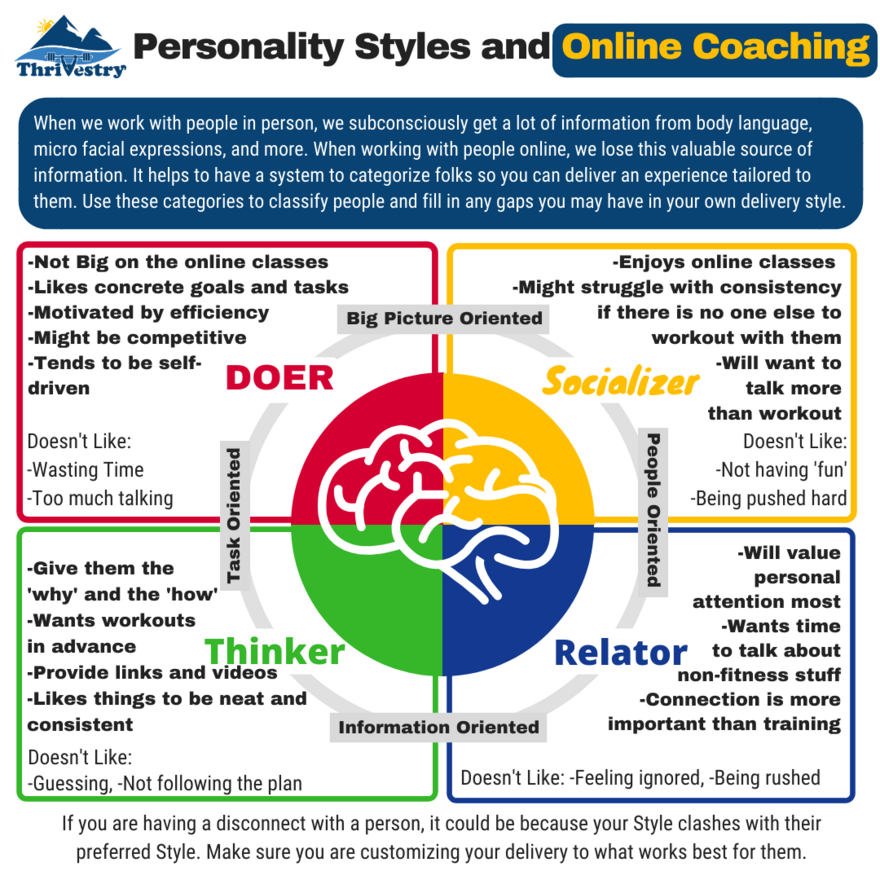
When working remotely with people one-on-one or in a group, it is important to understand them from a personality-type standpoint. Here is a tool you can use to help deliver a better online coaching service!
This is a follow up to a previous article that was geared toward coaching classes. You’ll want to check that out here. (it is kind of ‘required reading’ for this article).
I will also note that categorizing people will never be a perfect science. Humans have few categories that apply to everyone, and people may move in and out of ‘groups/types’ over time.
That said, using a system like this can help streamline interacting with large amounts of people and help you ‘switch gears’ between different types of people when bouncing from one client to another.
I’ve created some basic infographics to help you understand more about the different colors, but I highly recommend you check out equilibria.com to find out more information and even download their free app so you can take the test yourself!
Online vs In Person
When we are working with someone in meatspace (the real world), we are subconsciously absorbing information about them. Their micro facial expressions, body language, seeing how they interact with others and the environment… All of these things add up to help us connect on a human level.
The conscious stuff, what you are talking about and how they are moving, can be replicated decently online with modern tools. The subconscious stuff is harder to ‘read’ on text, phone, or video.
Side Note: Think of all the miscommunications people have when writing. Emails and texts are notorious for being ‘read wrong’. Without the tone of voice, body language, and other cues, the written word can be interpreted many different ways. This is one of the reasons emojis have become so ubiquitous. They act as a substitution for what is lacking.
Phone conversations are a step up from written communications. Video is a step up from phone. In-person trumps them all.
Knowing what Personality Style you are will help you connect with people who aren’t the same style as yourself when you aren’t interacting with them in person. By understanding your own biases and blind spots, you’ll be able to fill in your gaps and reach people more on their own level.
If you know your Style AND their Style, you’ll be able to tailor your interactions and delivery to make them feel the most satisfied with the experience!
Handling Each Style Remotely
Each style will receive online training differently. Doers, for example, won’t come to online live classes much. Socializers won’t workout on their own as often as they should. Here some thoughts on how to handle each style.
Doers
Doers tend to be task oriented and competitive. They tend to enjoy CrossFit because it is very time efficient and because things are measurable and repeatable.
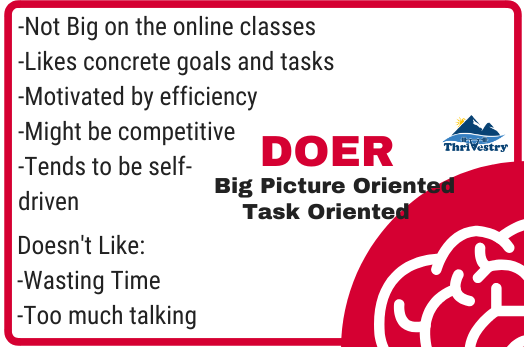
- They will not understand the point of doing a live class when they can do it on their own.
- They will be frustrated by technical issues and the inevitable hiccups that come when coaching a class online.
- Seeing people’s faces or talking to them isn’t a big driver.
- Attendance from your Doer folks will be low in online classes.
When they do come to a live video class, don’t make a huge deal about it publicly. Acknowledge their attendance and make sure they are staying busy the entire time. Give them an extra push. Set concrete goals/tasks for them. Start on time and stay on time.
Some Doers will be motivated by the performance of others, if you can incorporate that with them (by telling them that someone else is catching up or beating them), do it. One option that will make Doers more engaged is to figure out a way for everyone to visually mark on their camera feed what round they are on. The goal is show them that there are benefits to training “live” with others that outweigh the inconveniences (a specific time, dealing with technology, etc.).
Because they won’t be attending the live classes much, you’ll have to make up for it in other ways. Assign them lots of customized ‘homework’ they can do on their own. Be specific and follow up with them (text is fine here).
Get them to do some video one-on-ones. Spend your time giving them tons of instruction on what they should be working on offline. You might think about not doing a WOD but doing more testing and instruction. Avoid getting into small talk (unless they want to). Keep it task oriented and to the point.
Mostly, Doers tend to be self-driven. They will workout on their own. It is your job to give them the right workouts for them to do and concrete goals for them to hit. Customizing their training to create efficiency in their lives will show them value (and help you keep them as a client).
Socializers
Socializers gain energy from interaction with others. In particular, groups of people, and that is why they like CrossFit classes.

Where Socializers struggle with online training: they do not like to work out alone. If they don’t have people to train with, they are likely to postpone training or train much less frequently. Get them a training partner or have them join online live classes as much as possible.
- They will probably be the most consistent in the online live classes.
- They will enjoy seeing other people and interacting with everyone.
- Make time for them to interact before and after the class.
- Keep it fun and let them crack jokes or have the spotlight for a moment.
When you do remote one-on-ones with them, they will likely end up talking the entire time if you don’t stop them. Chat them up about non fitness related stuff but watch the clock and make sure you still provide value. Let them talk while they are doing stretches or mobility. You can talk to them while they are doing movements or even during their workout (they’ll want to hear about your life as well).
It is important that they do SOME working out during your session because they might not workout on their own between sessions!
Many Socializers who don’t have a group of people to workout with will struggle with consistency. They will require more check-ins and accountability when working with them remotely. Ping them once a day and get them in the habit of reporting back to you.
Giving them kudos or props online will motivate and encourage them. Give them shout-outs and try to like/comment on their posts.
Relators
Relators like to connect one-on-one. They prefer smaller gatherings and deep conversations. They like CrossFit classes that allow them to talk to friends.
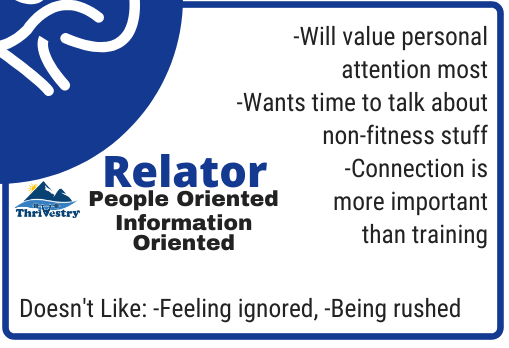
- Relators do fairly well with online training IF they are getting enough personal attention.
- They may enjoy online live classes (if they aren’t that big), but they’ll enjoy remote one-on-ones much more.
- When doing online classes, use the ‘breakout room’ feature to talk to them one on one or have the class broken up into smaller groups so they can connect with people (this can be done before, during, or after class). For example, you may ask a trivia question or ice-breaker question, then divide everyone into pairs or threes, to talk it out with each other.
Virtual one-on-ones and phone conversations are where they’ll feel the most loved. They’ll want to talk about everything (how they are doing, how you are doing, how your dog is doing…). Similar to the Socializers, let them talk (and talk yourself), but make sure you still get them to move and learn.
The training and the workouts will not be as important to them as it is the Doers and Thinkers. It is more important that they feel connected to you. They generally require more DMs and text messages than other Types (usually about non fitness related stuff).
Thinkers
Thinkers want to know the ‘whys’ and the ‘hows’. They usually like to plan, strategize, and debate. They like CrossFit because there is a system and a plan, and they can track their progress over time.
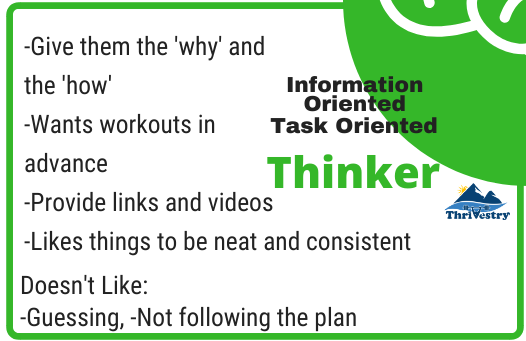
Thinkers can do well with online training with the right approach.
- They’ll want their workouts in advance with explanations and resource material (links and videos).
- They want time to ask questions.
- They want consistency and little to no errors (like typos).
- The more you can customize their programming (and tell them why), the better.
If you just send them a workout without any extra information, they are less likely to do it. Tell them why they are doing it and how it is going to benefit them, and they will be more invested in making it happen.
If your online live classes have a lot of instruction and information, AND people are able to ask questions, Thinkers will keep coming back. Otherwise, they’ll just catch the recording/workout posted and do it on their own.
Thinkers will enjoy the virtual one-on-ones if they get to pick your brain and challenge you. But that doesn’t mean they’ll want to talk the whole time. They are still fairly task oriented so keep them busy and talk while they are moving. Just make sure you give them time to ask questions or clarify something.
When working with them remotely, they generally won’t be interested in a lot of chit-chat or basic check ins. They’ll appreciate more information: instructions, articles, videos. They will also be the best at logging their workouts (so use that tool to communicate with them as well). Show them that you are using their previous performances to tailor their training (and why).
Putting it into Practice
You should have a file for each client that tracks their goals, routines they are working on, and workouts of course. But you should also have which type they are, and some notes about their preferences.
Review this file before each interaction with them. If you have a class of people, it might be good to go through the list and review everyone’s Style and see if you can tailor the class to the people in it. For example, if the class is all Socializers and Relators, you should make it more fun and allow time for interactions. If it is almost all Thinkers and Doers, stay organized and on track. The Socializers and Relators will get some satisfaction by just being there (and you can do some bonus stuff after the official class is over).
I would also like to reiterate that categorizing people is a very ‘blunt tool’. This, Myers Briggs, DISC, and other systems (like the ‘what-kind-of-potato-are-you-quiz’), are NOT scientific. People’s personalities change over their lifetime and even day to day. We shouldn’t think of these things as concrete and we should always recognize that people are complex individuals and grouping them has limitations.
That said, simple heuristics like this can save you a lot of time and brain power. Especially when working with large volumes of people that you can’t meet in person as often as you’d like!
Thrive on.
-jj
(Here is the original info graphic with that works for coach/client relationships in class):
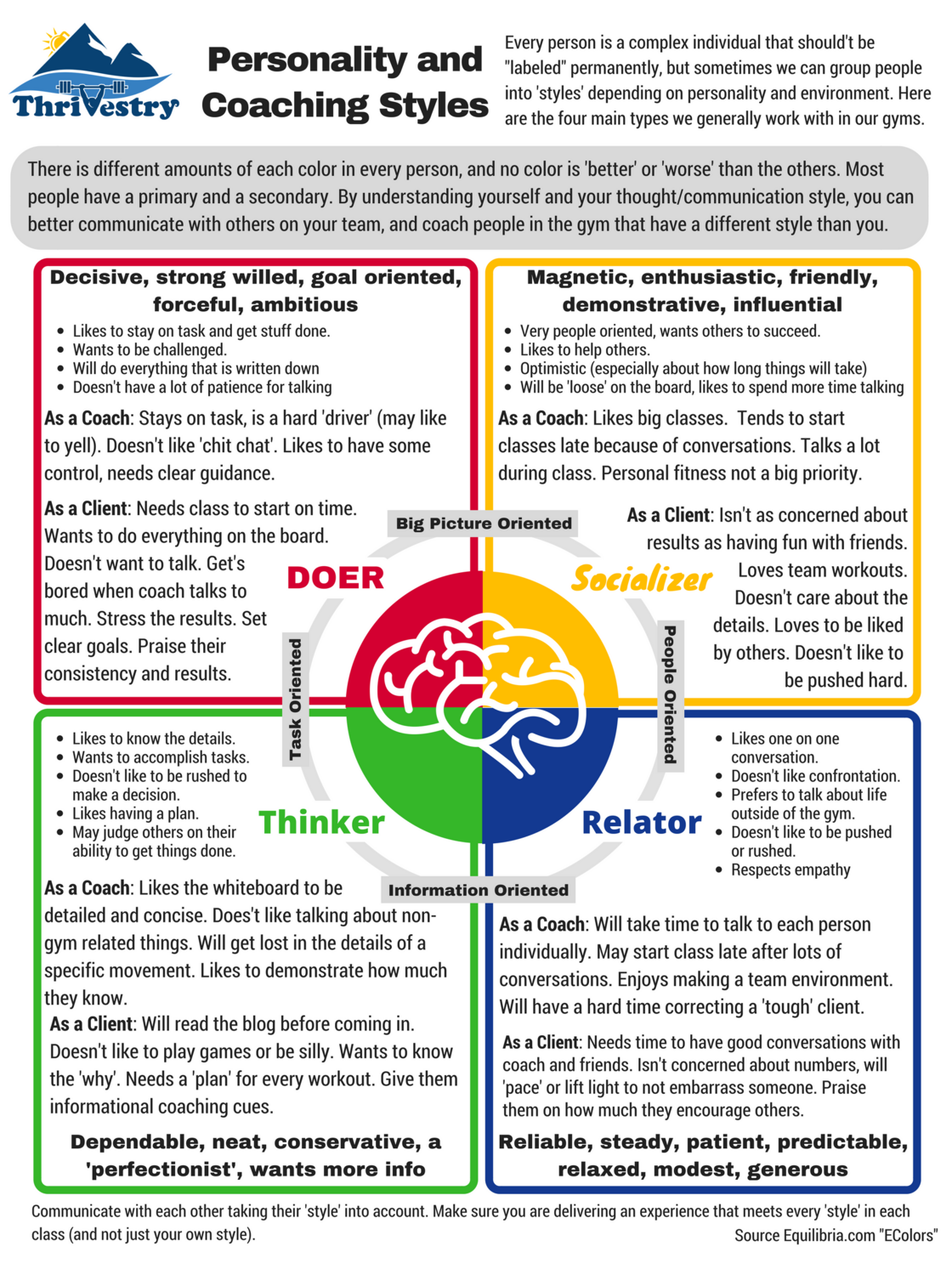
Please share this if you found it useful or if you think it might help someone else.
Here are a few other things you may find interesting:
Building a Gym to Last 100+ Years? Don't Forget This Key Ingredient
Is there one thing you can focus on that will give your business the greatest chance of lasting 100+ years? What does this have to do with learning the Fox Trot?
The BIGGEST Problem with the Fitness Industry
What if I told you there needs to be a monumental shift in the fitness industry?
Fitness professionals, enthusiasts, and facilities are focusing on the wrong things...
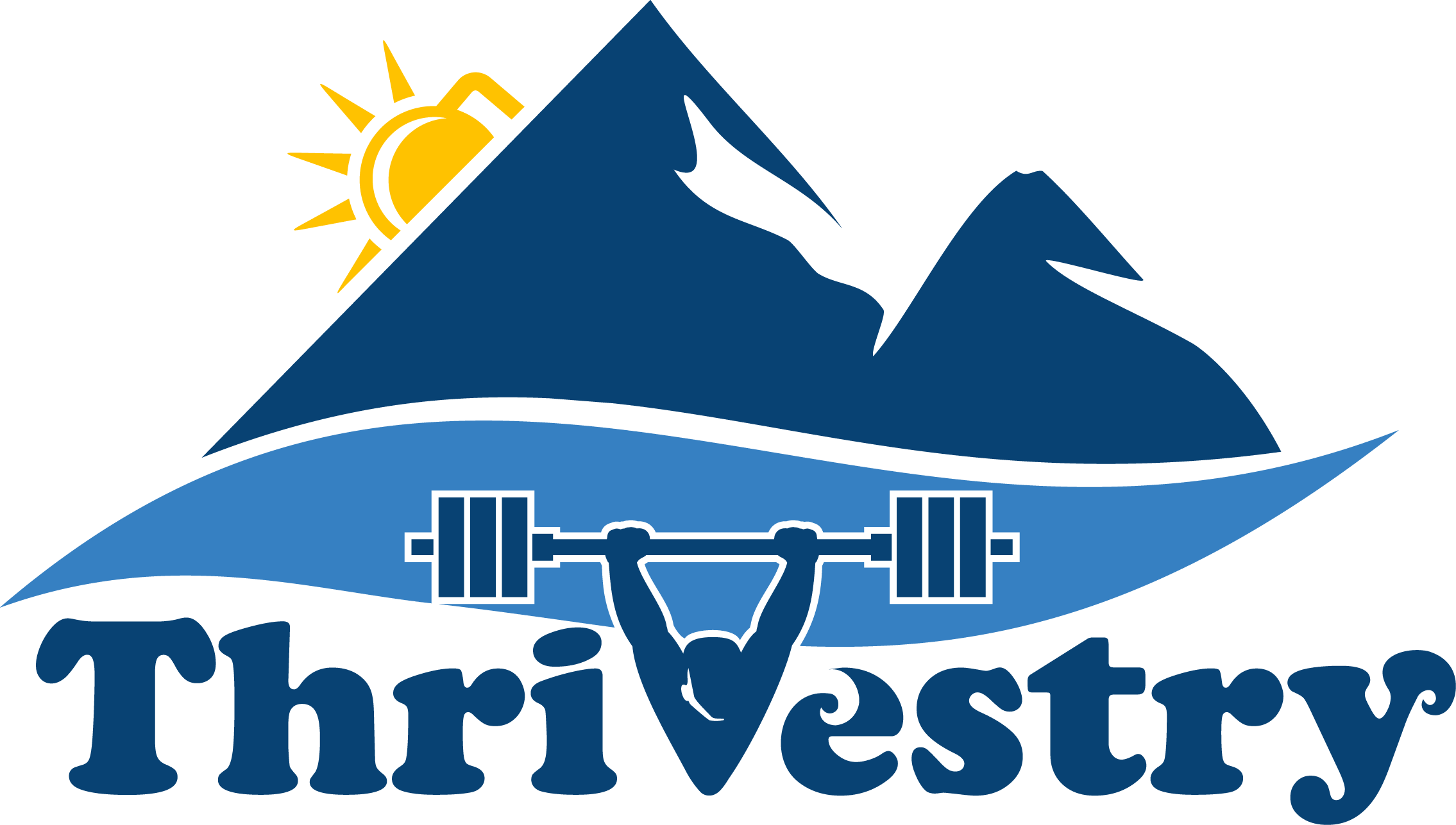
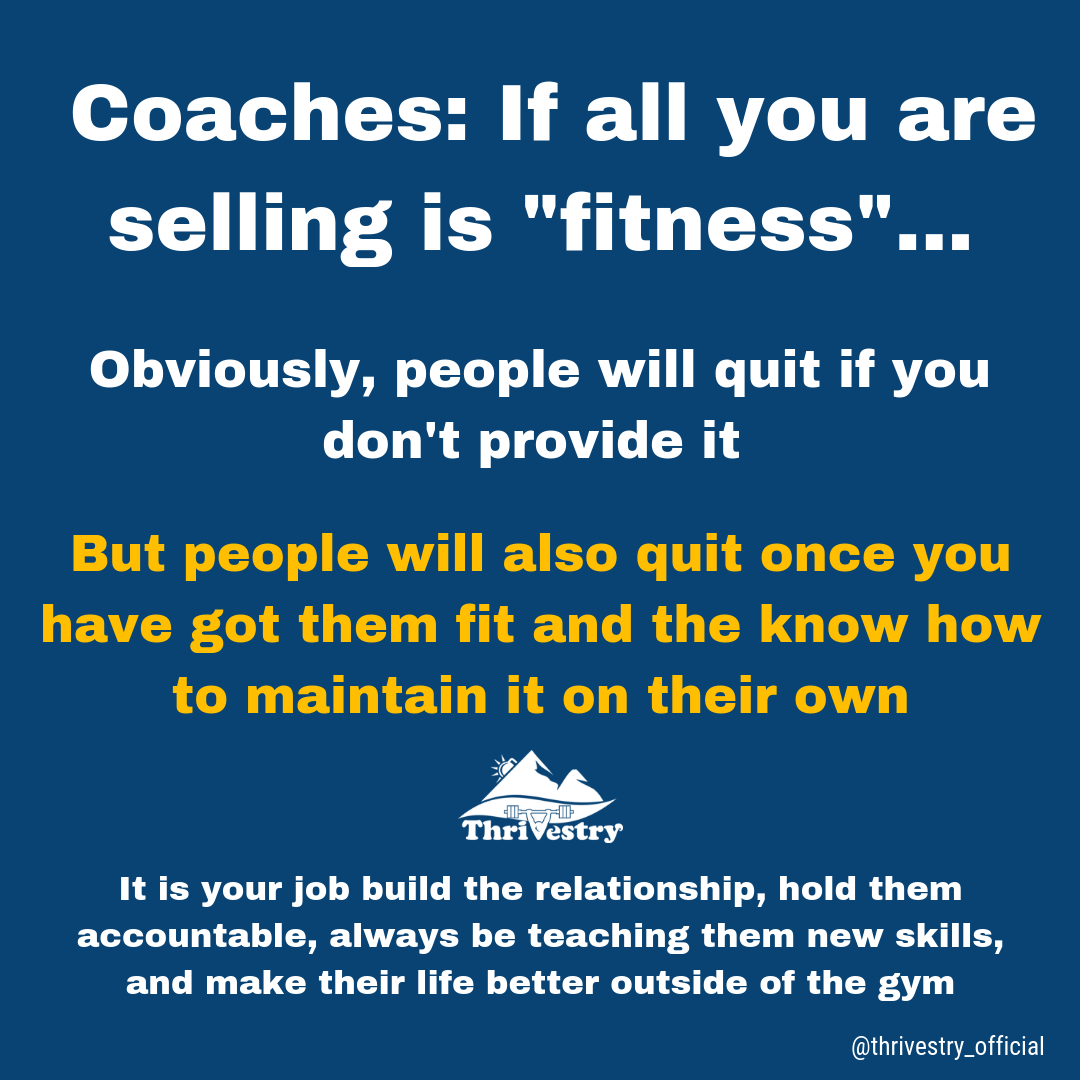

0 comments
Leave a comment